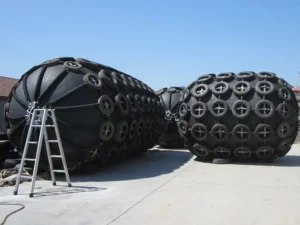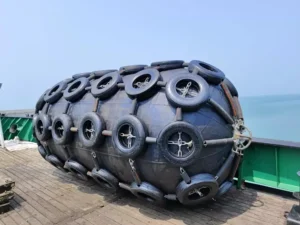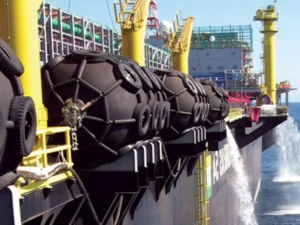Introdução
Você sabe o que ajuda no processo de atracação de navios com segurança? São os diferentes tipos de defensas que, além de absorverem a colisão, também ajudam em diversos acidentes marítimos. Um dos melhores tipos que aparecem no topo é o para-lama pneumático. Mas há outro para-choque Yokohama. Hoje, entenderemos por que o chamamos de para-lamas Yokohama e qual é a sua origem.
Vamos ter uma discussão detalhada!
A origem das defensas marítimas
Você já se perguntou o que as pessoas usavam para se proteger durante uma colisão? Existiam defensas marítimas Yokohama no início ou não?
A resposta simples é não. Antes da Segunda Guerra Mundial, não havia o conceito de defensas pneumáticas para navios. As pessoas costumavam coletar a pele de baleia, especialmente no Japão, e usavam-na para absorver a energia da colisão.
Adivinhe o que aconteceu? Ele foi muito eficaz na proteção durante uma colisão. Mas pegar a carcaça da baleia era uma tarefa um pouco agitada. No Japão, isso era feito para fins de caça. Portanto, o conceito da carcaça também veio do Japão.
Mas havia muitos problemas com a carcaça da baleia.
- Era difícil caçar uma baleia e matá-la para retirar a pele.
- Depois de alguns dias, a pele da baleia começou a produzir gases tóxicos. Esse era um fator de risco para a vida humana.
- Os odores desagradáveis também causavam vários problemas para as pessoas.
O mundo ocidental lutou continuamente para encontrar uma solução melhor e mais confiável. Então, surgiram os para-lamas Yokohama.
Quando as defensas marítimas da Yokohama foram inventadas?
Talvez você se pergunte quando foram introduzidos os para-lamas flutuantes de borracha pneumática. Foi em 1958 que a Yokohama Rubber Company de Tóquio, Japão, desenvolveu os para-lamas.
Mas havia um grande problema com o tamanho. Se a empresa tivesse que fabricá-lo cheio de borracha, seria necessária uma quantidade considerável de borracha, o que era difícil de conseguir e caro. Portanto, nem todos podiam pagar por isso. Após uma pesquisa minuciosa, eles criaram a tecnologia pneumática.
Então, qual foi o primeiro Fender naquela época?
Era uma bola cilíndrica de borracha preenchida com ar usada para comprimir e absorver toda a energia da colisão. Com o tempo, a empresa aprimorou seu enchimento pneumático e ofereceu aos usuários uma opção acessível.
Para generalizar o uso do para-lama Yokohama, a ISO emitiu as certificações para fabricantes confiáveis. Hoje, encontramos o uso do para-lama pneumático da Yokohama em toda parte.
Por que o chamamos de para-choque de borracha pneumática Yokohama?

Essa é uma pergunta empolgante que passa pela cabeça das pessoas. Mas você sabe qual foi o primeiro fabricante? Foi a empresa de borracha Yokohama. Eles o apresentaram como Yokohama Fender. Como o material é preenchido com ar de alta pressão, nós o chamamos de pneumático.
Foi assim que o nome veio do Japão. Atualmente, há muitos fabricantes em todo o mundo produzindo para-lamas de alta qualidade.
O surgimento do para-choque de borracha pneumática da Yokohama
1958 foi apenas o início de uma nova era de defensas de borracha. Hoje, a defensa de borracha pneumática Yokohama se destaca como uma valiosa ferramenta de segurança que deve estar disponível em todas as praias e embarcações.
Do Década de 1950 até a década de 2020, As defensas pneumáticas da Yokohama percorreram um longo caminho, espalhando-se por todo o mundo. Elas são ferramentas essenciais em aplicações de navio para navio ou de navio para berço e ajudam na segurança.
Hoje em dia, em todos os portos, você pode encontrar essas defensas. Além disso, o aprimoramento da tecnologia aumentou seu desempenho com as novas táticas.
As defensas da Yokohama valem a pena para a aplicação em sua embarcação?

Sim. Cem por cento. Se você quiser garantir a segurança de seus barcos em várias aplicações, não procure mais do que as defensas da Yokohama. Elas têm várias vantagens com relação a preço, manutenção e atracação. Vamos conhecer!
-
Útil em atracação inclinada
A atracação inclinada é um fenômeno crucial que aumenta o incômodo do trabalho. Na atracação, o primeiro contato geralmente é feito a 45 graus. Isso exerce impacto sobre a doca e o barco.
As defensas sólidas falham nesse ponto devido à compressão inclinada nessa parte, que não oferece muita energia para ser absorvida durante a fase de atracação. Em comparação com isso, as defensas pneumáticas contêm ar de alta pressão pronto para assumir a alta força de compressão gerada durante a atracação inclinada.
Ele transfere a maior parte da pressão para seu corpo e evita danos durante a atracação. A função primária foi benéfica nesse caso.
-
Absorver a força de cisalhamento
O contato do barco com a doca não significa que ele tenha sido atracado. O movimento lento exerce uma força de cisalhamento. As defensas sólidas não são muito eficazes em um cenário como esse.
As defensas pneumáticas têm alta resistência para absorver a força de cisalhamento e ajudar no processo de amarração. Você está mais do que seguro com as defensas pneumáticas.
-
Trabalhar em condições extremas
Seja qual for a estação do ano ou mesmo quando há marés pesadas no oceano, as defensas Yokohama continuam funcionando. Elas podem funcionar a -50 graus Celsius. É impressionante quando você pode usá-las em qualquer situação e obter o melhor desempenho.
Em ambientes adversos, eles são adequados devido à sua resistência, enquanto um para-lama sólido não ajudará muito.
-
Perda mínima de desempenho
O envelhecimento é um processo padrão não apenas para os seres vivos, mas também para os não vivos, como as borrachas. É por isso que um para-lama de borracha sólida, após anos de trabalho, começa a perder desempenho devido à absorção de energia.
Não se preocupe com as perdas de desempenho dos para-lamas flutuantes da Yokohama. Eles não perdem a resistência, tudo graças ao enchimento de ar. Sempre que achar que elas não estão apresentando o desempenho ideal, considere o enchimento de ar e um pouco de manutenção. Tudo isso garantirá um rápido retorno ao desempenho anterior que você espera de um para-lama.
-
Simples de instalar
Se você for um amador, poderá instalar os para-lamas Yokohama. Eles são fáceis de instalar por causa de seus mecanismos leves e fáceis de entender.
Além disso, são fáceis de transferir de um lugar para outro.
-
Mais barato e de fácil manutenção
Sabe o que há de melhor nos para-lamas pneumáticos? Eles são super baratos. Por quê? Por causa da alta pressão, que é quase gratuita. Não há muito uso da borracha. Portanto, o custo geral dos para-lamas pneumáticos é significativamente menor em comparação com a mesma variedade de para-lamas sólidos.
Mais uma coisa: não é necessário fazer manutenção diária. Para a manutenção, você pode monitorar o ar pressurizado e a aparência externa. Ele perderá força e tônus quando o ar acabar. A manutenção mensal ou anual também economiza alguns dólares, o que faz com que o negócio valha a pena.
Quais são as aplicações dos para-lamas Yokohama?

As defensas da Yokohama têm diversas aplicações em vários setores. Faça uma rápida análise das diferentes aplicações das defensas Yokohama.
-
Operações offshore de navio para navio
Durante a viagem no oceano, os navios precisam transferir contêineres ou outras ferramentas de um navio para outro. Para estabelecer uma conexão, os dois navios precisam se aproximar e se conectar. Essa pode ser uma tarefa arriscada porque as ondas da água produzem movimento e forças de colisão.
As defensas da Yokohama proporcionam o amortecimento necessário e absorvem toda a força. Isso resulta em várias operações offshore de um navio para outro.
-
Atracação de navios
A atracação de navios é um processo complexo. Seja uma atracação permanente ou temporária, o processo gera muitos riscos de danos aos navios. Quando um barco está próximo ao local de atracação, ele pode precisar de uma força de atracação inclinada.
As defensas Yokohama se destacam como o único e fiel ajudante nesse caso. Elas facilitam todo o processo de atracação e otimizam a saúde dos barcos.
-
Navios-tanque de petróleo e gás natural
Você sabe como ocorre a transferência de petróleo de um país para outro? O transporte aéreo não é um método eficaz devido aos vários riscos de ignição. O transporte marítimo é uma opção fantástica e econômica.
As defensas da Yokohama ajudam a garantir a segurança do transporte, apoiando a carga de óleo. Em caso de atracação ou colisões, não há problema quando as defensas da Yokohama estão presentes.
-
Usos de instalações temporárias
Mesmo que você queira uma instalação temporária das defensas nos locais de atracação, as defensas da Yokohama permitem isso - os recursos fáceis de transportar e o design compacto economizam tempo e ajudam na instalação rápida.
Muitos locais ao redor dos navios e portos precisam de substituições regulares e instalações temporárias. Nesses locais, as defensas pneumáticas são preferíveis às defensas sólidas.
-
Aplicações de proteção contra colisão
Quer se trate de uma colisão entre dois barcos ou de uma colisão no local de desembarque entre o barco e o local de desembarque, as defensas da Yokohama têm usos práticos em ambos os locais. As características de alta absorção de energia garantem seu uso duradouro nesse setor.
Conclusão
Explorar uma defensa marítima de alta qualidade é uma opção de ponta para seus barcos. Você terá uma solução duradoura sem muita preocupação com as defensas.
Você quer defensas marítimas de alta qualidade?
Lembre-se do nome -Jerry Borg Marine. Temos mais de 15 anos de experiência no setor de defensas e produzimos defensas pneumáticas de qualidade premium para navios. Explore nossos principais tamanhos de defensas Yokohama agora mesmo!
